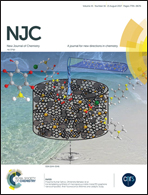Electrochemical synthesis of diverse sulfonamide derivatives depending on the potential electrode and their antimicrobial activity evaluation†
Abstract
Electrochemical synthesis of two different series of sulfonamides has been performed using the same precursors, 4-(4-nitrophenyl)urazole and arylsulfinic acids, by controlling the potential during electrolysis. Electrochemical reduction of 4-(4-nitrophenyl)urazole has been studied in the presence of arylsulfinic acids. The results indicate that via a paired electrosynthesis 4-(4-nitrophenyl)urazole is reduced at the surface of the cathode. The reductively generated 4-(4-aminophenyl)urazole is subsequently oxidized at the surface of anode. The electro-oxidatively generated 4-(4-aminophenyl)-3H-1,2,4-triazole-3,5(4H)-dione participates in a Michael-type addition reaction with arylsulfinic acids to form the corresponding sulfonamide derivatives. Potassium ferrocyanide was added to the electrolysis cell to prevent oxidation of 4-(4-nitrophenyl)urazole and to improve the yield of the products. Cathodically generated 4-(4-aminophenyl)urazole is oxidized by both direct (at the surface of anode) and indirect (using a ferricyanide/ferrocyanide redox mediator) electron transfer. The other part has been devoted to direct electrochemical oxidation of 4-(4-nitrophenyl)urazole in the presence of arylsulfinic acids in a divided cell leading to the synthesis of the second series of sulfonamides. Furthermore, electrochemical oxidation of 4-cyclohexylurazole has been investigated in the presence of arylsulfinic acids, and the mechanism of the chemical reaction coupled with electron transfer has been discussed by cyclic voltammetry, controlled-potential coulometry, double-step chronoamperometry and double-step chronocoulometry. All synthesized products were obtained in good yields using an environmentally friendly method and green solvents. The synthesized sulfonamides were tested for antimicrobial activity against E. coli PTCC1330, P. aeruginosa PTCC 1310, S. aureus PTCC 1337, Salmonella Typhi PTCC 1709, Aspergillus niger PTCC 5012, and Candida albicans PTCC5027. The compounds were mostly effective on fungi. The results confirmed that two derivatives are highly effective on all of the tested indicator microorganisms.



 Please wait while we load your content...
Please wait while we load your content...